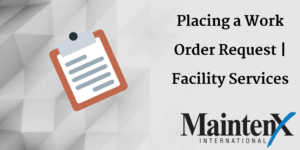
Generally, work orders are tasks assigned to a company’s maintenance staff or an external service provider. They can be submitted internally or externally, depending on the business and its maintenance structure. Facility Services, which fulfills the orders, usually houses maintenance and repair technicians, as well as supervisors and scheduling staff.
A work order request can include information and questions regarding:
– Directions
– Cost estimates
– Date and time of request or incident
– Procedures
– The person or service in charge of fulfilling the request
A work order request could be for maintenance or repair, and could come from staff, customers, or maintenance employees. They can be submitted to address specific problems or preventive maintenance.
Maintenance Request Process
Many companies have their own unique procedures, but the process usually goes like this: a work order request is reviewed by FS and, upon approval, a maintenance work order is made and assigned to a department, service, or maintenance employee, and given a priority.
Priority
A burst water pipe is much more of a problem than a leaky faucet. That’s why Facility Services usually has a priority system in place. For example:
– Emergency: An immediate danger to people, property, or environment.
– Urgent: A possible or probable danger to people, property, or environment.
– Concern: Work which must be done quickly.
– Routine: Regular service or maintenance which doesn’t pose any immediate danger to people, facilities, or equipment.
– Planned: Work scheduled for when resources and staff are available. Examples of this include HVAC maintenance checks, gutter inspection, and fire alarm tests.

